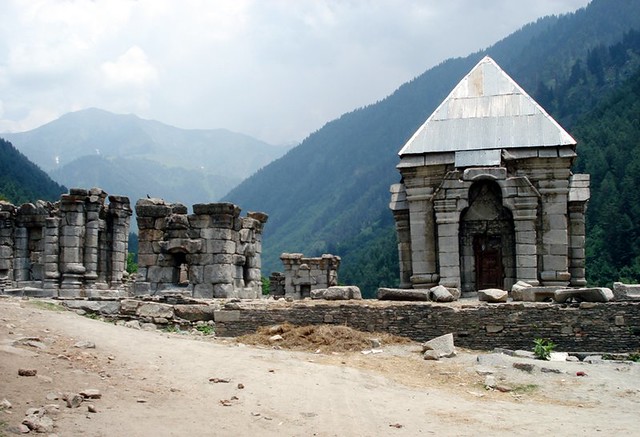Wangath is a place near Naran Nag, in the Sindh
Valley, and is ahead of Kangan; district Srinagar (now district
Ganderbal) is famous for cluster of ancient temples, now in ruins, of
Bhuteshwara, Jesthrudra and others. The temples are located at the foot
of the steep Bhuteshwara, near Naran Nag, 5 km to the North of Wangat,
in a dense forest of pine and fir trees in the lap of Harmukh Mountain.
Formally known as Sodaratirth, it is the location of temples commonly
referred to as the Wangath temples. The 12th century Bhutesvara temple
erected by King Jayasimha is the prime attraction. The ancient name of
Wangath was Vashisht Ashram.


Neelmata repeatedly makes
mention of Bhuteshwara Teertha or Sodar Naag or Sodar Teertha. Kalhana
too makes repeated mention of Sodar Naag or Naran Nag in Rajtarangini.
To quote Taranga I canto 107 and 347, Taranga II canto 123 and 139 and
Taranga IV canto 189, he too calls it Bhuteshwara or Bhutesha and Sodar
Teertha. Again the spring inside this temple complex is referred to as
Sodar Naag by him. Kalhana makes it clear that this temple complex was
patronized by various kings of Kashmir. King Jaluka (137 BC) erected a
stone temple at this site dedicated to Shiva Bhutesha. Kalhana adds that
King Jayendra (61 BC) would come to worship Shiva Bhutesha at this
temple complex. King Lalitaditya (713-735 AD) donated a good sum of
money to this shrine after one of his victory expeditions. King
Avantivarman (855-883 AD) built a stone pedestal with silver conduit at
this shrine for bathing of sacred images. Kalhan’s family was also
devoted to this Teertha. His father Canpaka paid frequent visits to this
shrine. Kalhana’s uncle Kanka also happened to be a frequent visitor to
this shrine. The Teertha had a large number of Purohits who were paid
handsome salaries from the endowments created for the shrine. As per
Kalhana, the treasury of this shrine was plundered by King Sangramraja
of Kashmir (1003-28 AD).

According to Lawrence, “in antiquity
these ruins are supposed to rank next after those of Bumzu and Payech”.
According to the scriptures, Naran Nag, in earlier times, was
pilgrimages centre and was famous as Sodara Tirtha. With the passage of
time the shrine must have lost its importance but it is said that
pilgrims to Gangabal Tirtha continued to pay obeisance at this
pilgrimage centre. This ancient shrine has a holy spring called Naran
Nag, which has given the name Naran Nag to the locality. In the vicinity
of the holy spring are found ruins of the temples, which have got
buried almost completely and on the top of the largest, a pine tree has
taken the roots. A footpath by the side of holy springs leads on to the
height of Harmukh and to the height of Harmukh and to the mountain-lake
Gangabal, a celebrated place of pilgrimage, 5,000 feet further up at the
foot of Harmukh Mountain. It is said that Raja Narendraditya built the
small temples. According to Lawrence, “It is probable that the Wangath
temples were erected at different times by the returning pilgrims as
votive offering after successful accomplishment of the hazardous
ascent”. The surprising aspect about the temples is the fact that the
material with which the stones of the temple have been joined is not
known.


No comments:
Post a Comment